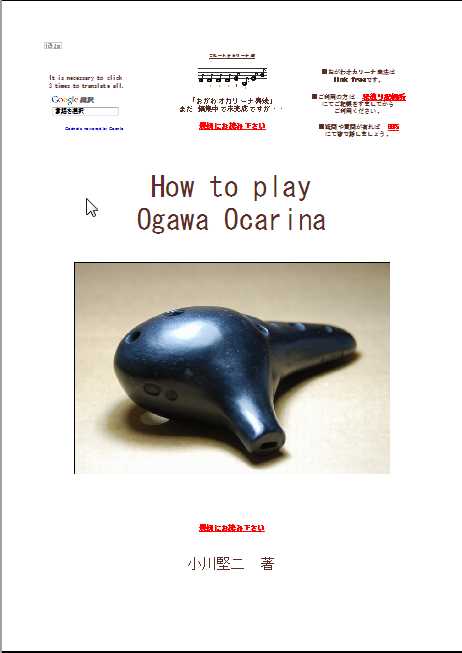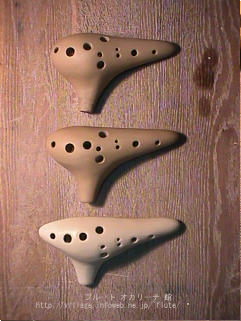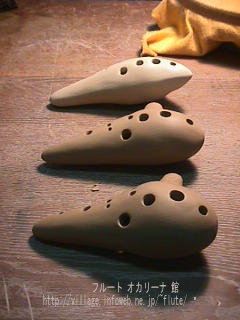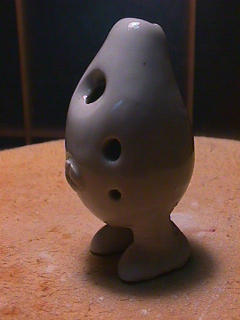Making of an ocarina
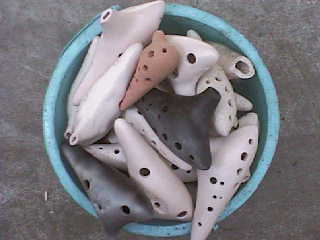
@
The ocarina making method described here has been developed by myself. I haven't been taught how to make an ocarina by anybody else, so I haven't been influenced by anybody. All the theories and rules you find here and Q & A session were created by my long-term experience of flute playing and teaching. I have taught others these things but I haven't been taught by anybody.
I applied for a patent (not just a utility model right) on unique technology for finishing the ocarina surface in April 1997. I also applied for an international patent on it in 1998. This means that no ocarina makers can produce an ocarina using this technology and that no one can play professionally an ocarina which was made using the method. (The patent is not related to the basic principle of the ocarina. Amateurs can make and use an ocarina for themselves using this method. Please write to me if you have questions. ) @
Making an ocarina is not just making a thing.
If you ask me, focusing on appearance of an ocarina or baking it at a high temperature is not a good idea. What you are making is the 'sound', not a 'form' or a color.
Professioanl musicians, whichever instrument they play, practice every day seeking for what is called 'their own sound' that emerges from inside of them.
If you look for the sound seriously, you have to make the instrument yourself. I wasn't able to find any commercially available ocarina which made my ideal sound. If you think the ocarina you play now the best one, that's OK. But when it comes to the time when you want to express YOUR sound or music, you have to make the instrument yourself.
It is a hard work for players of the clarinet, oboe, or bassoon to make their reeds, which enable the instruments to sound. If you look at their reed cases, you will find a lot of reeds aligned in them, but they say there are only a few that they can use at a concert. It is the same case with the ocarinas I have at home. There is only one ocarina which I think 'this is it'. The rest are almost same as rubbish as you see in the bucket in the photo above. Making a good ocarina is such a hard thing. That's why I didn't want to sell them until recently.
While ago, when I tried to make my first ocarina, I asked a couple of ocarina makers for advice. But they rejected to help me saying that it was a secret. (Now the situation has changed a lot. The makers who rejected me have published some of their 'secret'.)
I started making an ocarina believing that there shouldn't be a secret for such a simple instrument. Making an ocarina itself is very easy. But you need the knowledge and skill of pottery, and more than that, the taste and knowledge of music. You can't make a good ocarina if you lack either of them. (The knowledge of acoustics and hydrodynamics might also help.)
After a while, I had a chance to talk with an ocarina maker. I was surprised to know that he makes ocarinas without understanding even the basic of the ocarina. (Of course, it's OK as long as he can make good ocarinas.)
Not restricting to ocarinas, a famous instrument has indeed a good appearance too. However, a good-looking instrument is not necessarily a good instrument.
I think good players and makers of the ocarina will be coming out in the near future.
Muramatsu Gakki published my textbook of ocarina making and playing on April 22, 1990. I had a lot of opportunities to teach ocarina making, and put together what I taught in this book. I'd be glad it could help you some how. Please remember that I wrote only half of@the important information. It's not that I'm hiding another half. I'm doing so in order to leave room for you to have fun in thinking by yourself.
Inexpressible pleasure is yours when your first whistle makes sound!
Please judge your level if you make ocarinas.
1. Can make a Hato-bue (a bird whistle) (understanding of the principle)
2. Can make an octave.(the basic of tuning)
3. Can make all the notes. (the effectiveness of the sound hole. You have to make low 'La' to high 'Fa', which is essential)
4. Can make an instrument tuned to an aimed key.(The application of ocarina making.)
5. Can make an easy-to-control instrumentD(the harmonization with the playing technique and the music taste)
6. Can make your favorite sound (the sense to the sound)
(If your ocarina doesn't play from the lowest note 'La' to the highest note 'Fa', that would be due to your poor technique or the maker's laziness. An ocarina which needs high blow speed for the higher notes is not suitable for a high level performance. You should make an ocarina that you can play with a constant blow speed.)
From Ken's Ocarina factory
I changed the form recently. Rather than that, it is a modification of the previous form.
Still, the current best instrument is in the previous form. I wonder if I can make better one.
The white ones are previous works.
(The gray ones are still 'raw'. They are to be baked from now.)
This is a whistle doll for the practice of ocarina making. It is baked at a high temperature. Usually, ocarinas are not baked at high temperatures.
The is the basic of ocarina making
Route
Making of an Ocarina (Introduction I) [Ocarina making seminar](English)

